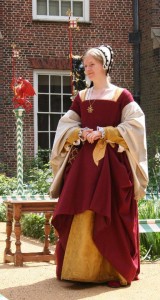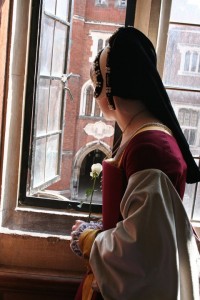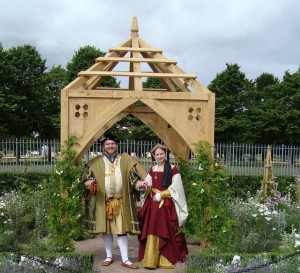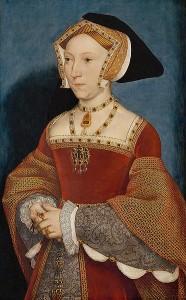
On this day in 1537, Jane Seymour died of puerperal fever at Hampton Court Palace. In this guest post, Lauren Johnson, a historian and author who regularly interprets Jane at Hampton Court Palace, considers how Jane ended up as Henry’s third – and many still argue ‘favourite’ – wife.
Over the past five years in my role as costumed interpreter at Hampton Court Palace I have played three of Henry VIII’s wives: Jane Seymour, Katherine Parr and Catherine Howard. Katherine Parr I admire immensely for her political savvy and intelligence; Catherine Howard is great fun to interpret and I feel a sort of older sisterly protectiveness for her; but Jane Seymour, whom I may have played most, is still, five years on, an enigma to me.
Here is a woman renowned for being meek and mild who we know argued with Henry about political and religious matters; who was famously virtuous, yet was betrothed to the King the day after he had killed his previous wife.
Jane is popularly remembered as Henry’s ‘favourite’ wife – the one who appears in the family portraits, the one he was buried next to. And it is interesting that Jane, just like Anne Boleyn and Catherine Howard, is often assumed to have been nothing but a pawn in the ambitions of her male relatives and allies. We imagine a poor shrinking pale figure, dangled in front of the King to bait him away from his previous wife. But this doe-eyed innocent is not the Jane that I have come to know. After all, we cannot forget that Jane succeeded as queen only on her predecessor’s death – as Agnes Strickland put it with a characteristic Victorian flourish, ‘she gave her hand to the regal ruffian before his wife’s corpse was cold’.
So what was it about Jane that enticed Henry VIII into marriage? And why, given what happened to her predecessor, was she willing to marry him?
It tends to be assumed that women had no choice in whether they married Henry VIII or not. Yet we know, from a surviving letter of Katherine Parr, that she viewed his proposal as an offer, not a command. She wrote to her last husband, Thomas Seymour, that she would have married him in preference to Henry in 1543, but that God had driven her to accept the King and ‘made me renounce utterly mine own will’. It was her conscience, not the prodding of her family or fear of Henry’s reprisal that drove her to become queen. She knew the influence that she could have over matters of religion and politics, and was willing to accept marriage to a man twenty years her senior as the price for it.
It is also worth bearing in mind that in 1536 Henry was not the bloated, choleric beast of a decade later. The famous ‘Holbein’ portrait of him – painted around the time of his marriage to Jane – shows a man broader than he once was, but still imposing, and still palely handsome.
I believe two things drove Jane to marry Henry: politics and vanity. The influence of the latter should not be underestimated when it comes to Henry’s wives.
It is impossible to imagine now – in this age where the royal family takes pains to appear to be ‘of the people’ and is constantly visible to us on TV or the internet – how it would have felt to be in the presence of a Tudor monarch. Henry was anointed king by God, had ruled the country since Jane was a child and, as the Great Bible that was issued in 1540 clearly showed, was second only to God in the grand scheme of power. Most people in England would only have seen their King’s face on the coins in their pocket, or if they were well-off perhaps in a portrait. To be in the six foot plus presence of the King, and receive his attention, must have been awesome, in the old sense of that word. Moreover, we should not forget that Henry was a true renaissance prince: a warrior hero and chivalrous knight, apparently just as happy to design naval bases as compose poetry and music. His subjects could hardly help being puffed up by his attention – and not just the women. Thomas Cromwell and Thomas More, just like Anne Boleyn and Catherine Howard, may well have lost their lives out of a misguided belief that because such a man had adored them once, he would always do so. It would be astonishing if Jane, described by the imperial ambassador Eustace Chapuys as ‘incline[d] to be proud and haughty’, did not have her head turned by royal attention.

However, even from the earliest appearances of Jane in surviving records, it was clear that there was more to her interest in the King than just vain gratitude. In April 1536 Chapuys wrote to his master, Charles V, about Henry’s attentions towards ‘Mrs. Semel’, and it is telling that he had received his information about her from the Marchioness of Exeter. Exeter’s family were long-time supporters of Princess Mary and thus implicitly opposed to the Boleyn marriage. Chapuys implied that Exeter and her allies were using the King’s affection for Jane to their cause’s advantage:
‘(She) has been well taught for the most part by those intimate with the King, who hate the concubine, that she must by no means comply with the King’s wishes except by way of marriage.’
Later that month, Chapuys explained that Nicholas Carew (another of Mary’s supporters) ‘continually counsels Mrs. Semel and other conspirators’.
In other words, Jane was no passive instrument during Henry’s courtship. She had a clear political agenda, and moreover a faction at Court supporting and promoting her. Even before Anne Boleyn’s arrest, when the King discussed their future marriage, Jane proposed the restoration of Princess Mary to the succession. Henry responded angrily that she ‘ought to study the welfare and exaltation of her own children, if she had any by him, instead of looking out for the good of others’. David Starkey has interpreted Chapuys’ reports to mean that Jane was nothing but a mouthpiece for Carew and Exeter, but Jane would not have been so successful if she had not personally been clever. Chapuys might have declared she was ‘not a woman of great wit’ but Jane clearly knew how to play Henry, and in this first potentially dangerous encounter, she acted her own part excellently. Jane told Henry that ‘in soliciting the Princess’s reinstatement she thought she was asking for the good, the repose, and tranquillity of himself, of the children they themselves might have, and of the kingdom in general’. She turned Henry’s argument right back around to appear once more the perfect future queen. Her concern was for him and England, not for herself. Even Chapuys was impressed.
Throughout her queenship, Jane attempted to use her influence on Henry to further her causes. Once married, she continued to pray and plead for Mary’s restoration, which did ultimately take place, and during the Pilgrimage of Grace – the Northern rebellion opposing the religious changes of Henry’s government – she went down on her knees before the King, begging him to reverse the dissolution of the monasteries and restore the abbeys. On the latter occasion, Henry demonstrated a bullying instinct, ‘reminding her that the last Queen had died in consequence of meddling too much with State affairs’. Understandably, we do not hear of any repeated political interventions on Jane’s part. However it is easy to imagine that, once buoyed by her status as mother of the heir to the throne, had Jane lived she would have been in a stronger position to argue for her political concerns.
Thus, Jane clearly had a political agenda in marrying Henry. Like Katherine Parr, perhaps she believed God had driven her towards this marriage – unlike Katherine, we unfortunately have no document that clearly states her motivation.
And what about Henry? Chapuys’ description of Jane on first learning of the King’s interest in her is far from flattering. She was ‘of middle stature and no great beauty, so fair that one would call her rather pale than otherwise’, ‘not a woman of great wit, but she may have good understanding’. As Starkey puts it: ‘What was there here – a woman of no family, no beauty, no talent, and perhaps not much reputation – to attract a man who had already been married to two such extraordinary women as Catherine and Anne?’

Most people tend to assume that Jane’s main attraction was her contrast to Anne Boleyn. Anne was dark, Jane was pale; Anne had a temper, Jane was pacific; Anne argued passionately with the King, like an equal; Jane played the ‘inferior female’ card. It is easy to imagine that after nine years Henry had tired of the sheer effort of a relationship with Anne. He might accept challenges – even a defeat – on the tiltyard, but in married life things were supposed to be different. A husband ruled his wife, and a king certainly ruled his subject. It is this fundamental truth that Jane, and probably Henry’s later wives, grasped. But Anne, who had been set up as Henry’s perfect partner from the earliest days of their courtship, raised to a rank no woman had ever previously possessed and given a coronation to match her new status – well, why should she view herself as inferior? Henry had done everything he could to create her in his image, and then decided he didn’t like the reflection talking back.
The characteristic that was often repeated in reference to Jane as queen, which must be key to Henry’s decision to marry her, is her gentleness. Sir John Russell reported her to be ‘as gentle a lady as ever I knew’ while Henry himself told Chapuys that ‘he imagined that (Jane) would do her utmost to obtain the title of pacificator (guardian of peace)’. She was the perfect Tudor woman, as she proved in her early dealings with Henry, going down on her knees and weeping when he sent her a gift of money. She begged that the King would not be angry, but also to remember that she was a virtuous woman and would not risk her honour ‘for a thousand deaths’ – she would gladly accept future gifts, as long as they were given after she was married (perhaps thinking of other women whose romantic attention was bought with hard cash). Jane put Henry in the position of pursuer, of romantic hero, while she was the willing – but clearly not too willing – object of his passion. It was a chivalric conceit that was bound to please Henry.

It is easy to imagine that Henry saw in Jane the opportunity for a little peace and quiet. And as with Anne Boleyn he responded angrily when his new wife spoke against him. Perhaps the crucial difference between Anne and Jane was that Anne saw no reason to fear Henry’s temper, while Jane – having watched the downfall of her predecessor – knew exactly where such displeasure could end. She also knew how to temper her own behaviour to avoid inciting that displeasure in the first place.
Perhaps it is so hard for me to get to the root of Jane’s character because the reports of her are so contradictory. Henry married her expecting a mousy, submissive wife – but even before he proposed she was clearly promoting one political faction at Court. To most modern minds, it is unthinkable to contemplate getting into bed with the murderer of the woman who was – to all intents and purposes – your boss. Agnes Strickland believed that Jane thus made herself a ‘slave’, forced into submission by a murderous husband. This is overstating the point, but it is hard not to imagine that Anne’s fate influenced Jane’s queenship. However, Jane’s choice to present herself as Henry’s ideal woman was just that – a choice. Whether she really was, as Chapuys suspected, haughty and proud or whether she was gentle and peaceful as Sir John Russell believed, she knew how to present herself to her future husband and the Court.
Perhaps we still underestimate Jane Seymour.
Brief Bibliography
- Letters & Papers, Volumes X-XI
- Calendar of State Papers, Spain, Volume V (Part 2)
- Elizabeth Norton, Jane Seymour: Henry VIII’s True Love (Amberley, 2009)
- David Starkey, Six Wives: The Queens of Henry VIII (Vintage, 2004)
- Agnes Strickland, Lives of the Queens of England from the Norman Conquest, volume IV (T.K. & P.J. Collins, 1850)
- Oxford Dictionary of National Biography:
Jane Seymour (Barrett L. Beer)
Elizabeth of York (Rosemary Horrox)
About Lauren
Lauren Johnson regularly interprets Jane Seymour with Past Pleasures Ltd., for whom she is also Research Manager.
Her debut novel, The Arrow of Sherwood, is published by Pen & Sword Fiction, and can be bought from Amazon UK – click here or Amazon.com – click here.
You can read more of her work on her blog or follow her on Twitter:@History_Lauren.
Jane Seymour’s Death
You can read more about Jane Seymour’s death in my article 24th October 1537 – The Death of Jane Seymour.